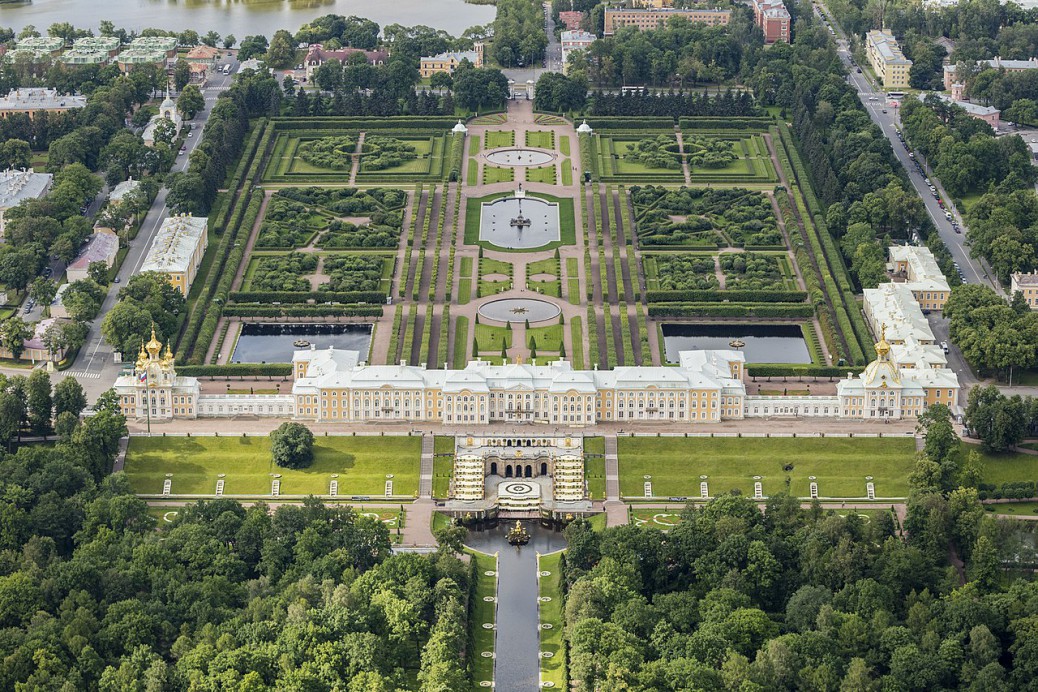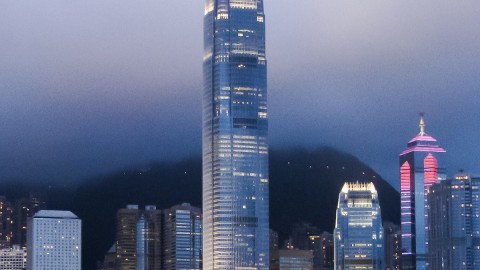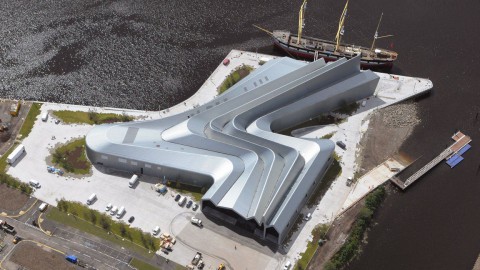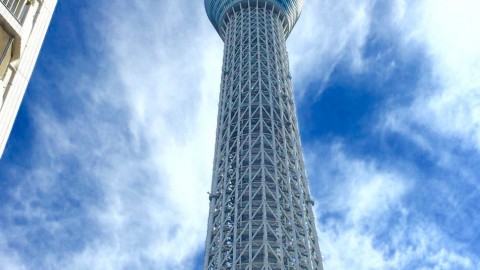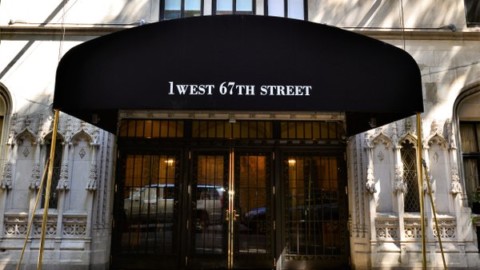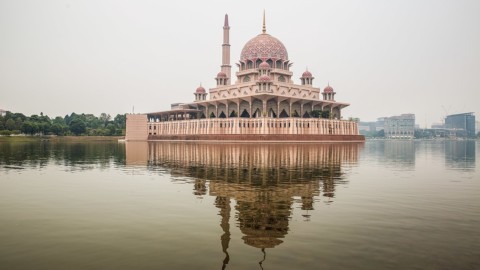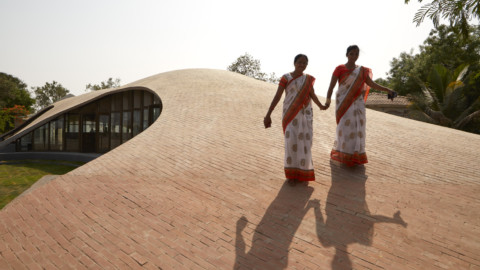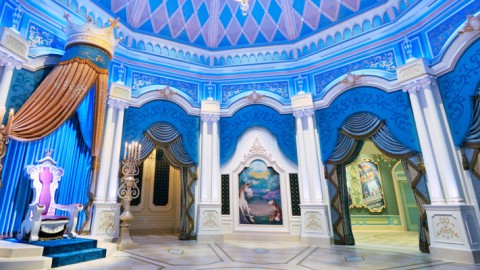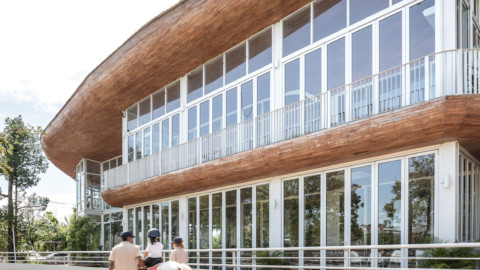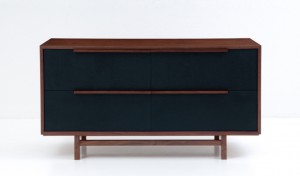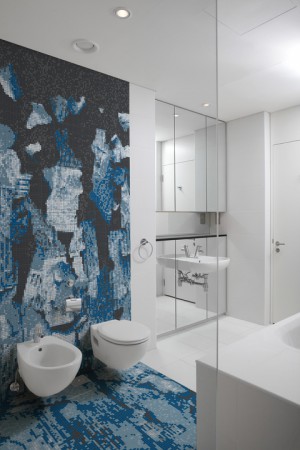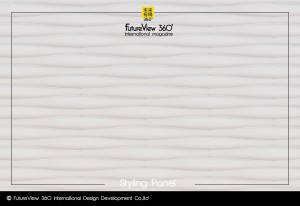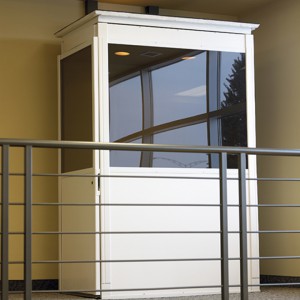Peterhof Palace 彼得夏宮宮殿
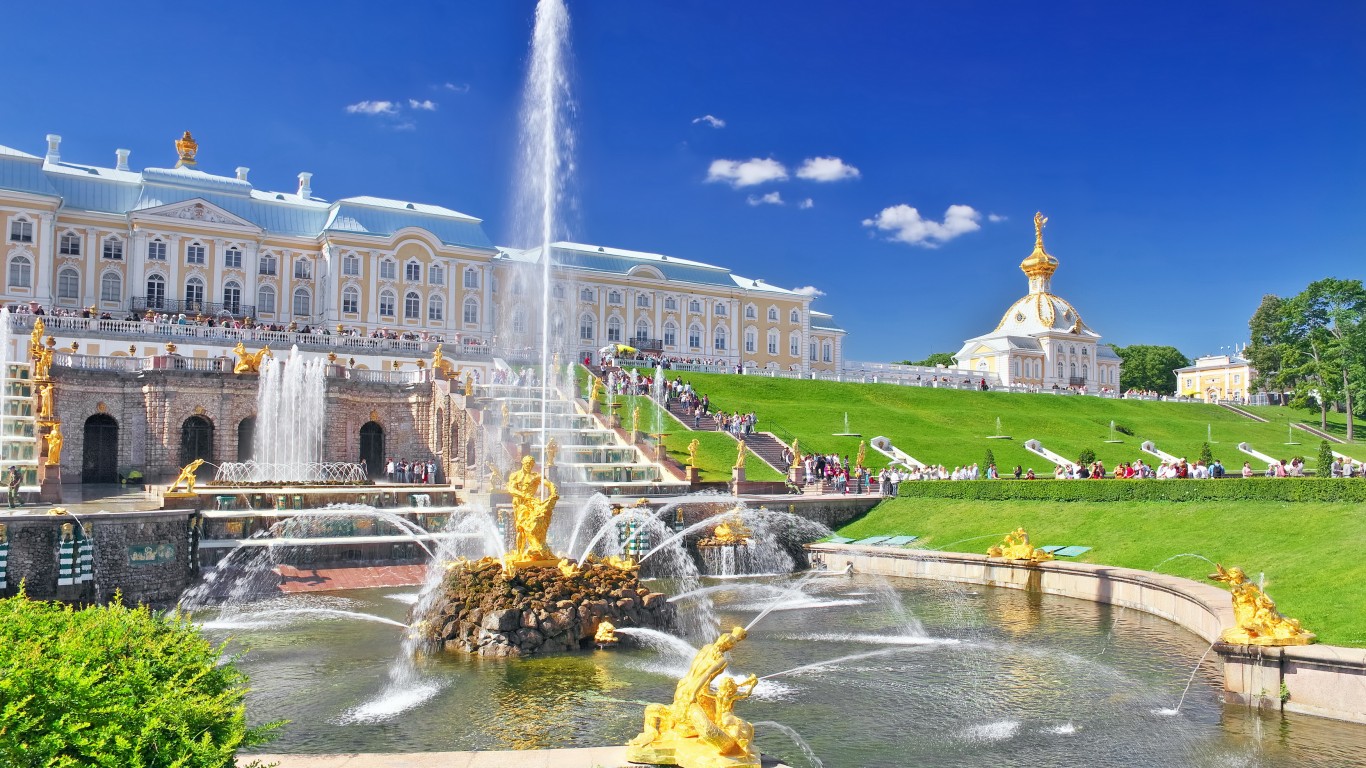
The Peterhof Palace (Russian: Петерго́ф, IPA: [pʲɪtʲɪrˈɡof],[1] German for Peter’s Court) is a series of palaces and gardens located in Petergof, Saint Petersburg, Russia, commissioned by Peter the Great as a direct response to the Palace of Versailles by Louis XIV of France. Originally intended in 1709 for country habitation, Peter the Great sought to expand the property as a result of his visit to the French royal court in 1717, inspiring the nickname used by tourists “The Russian Versailles”. In the period between 1714 and 1728, the architecture was designed by Domenico Trezzini, and the style he employed became the foundation for the Petrine Baroque style favored throughout Saint Petersburg. Also in 1714, Jean-Baptiste Alexandre Le Blond designed the gardens, likely chosen due to his previous collaborations with Versailles landscaper André Le Nôtre. Francesco Bartolomeo Rastrelli completed an expansion from 1747 to 1756 for Elizabeth of Russia. The palace-ensemble along with the city center is recognized as a UNESCO World Heritage Site.
彼得夏宮宮殿(俄語:Петергоф,IPA:[pʲɪtʲɪrɡof],[1]德國為彼得的法院)是位於俄羅斯聖彼得堡彼得宮的一系列宮殿和花園,由彼得大帝委託作為對宮殿的直接回應法國路易十四的凡爾賽宮。最初的目的是在1709年為國家居住,彼得大帝尋求擴大該物業,因為他1717年訪問法國皇家宮廷,激發了遊客“俄羅斯凡爾賽宮”使用的綽號。在1714年至1728年期間,該建築由Domenico Trezzini設計,他所使用的風格成為整個聖彼得堡青睞的Petrine巴洛克風格的基礎。同樣在1714年,Jean-Baptiste Alexandre Le Blond設計了花園,可能是因為他之前與凡爾賽園林師AndréLeNôtre的合作而選擇的。 Francesco Bartolomeo Rastrelli完成了從俄羅斯伊麗莎白到1747年至1756年的擴張。宮殿中心和市中心被聯合國教科文組織列為世界遺產。
Official name:Historic Centre of Saint Petersburg and Related Groups of Monuments
Criteria:Cultural: (i)(ii)(iv)(vi)
Reference:540bis
Inscription:1990 (14th Session)
Area:3,934.1 ha
官方名稱:聖彼得堡歷史中心及相關古蹟群
標準:文化:(i)(ii)(iv)(vi)
參考:540bis
題詞:1990年(第14屆)
面積:3,934.1公頃
Construction
The end of the Great Northern War resulted in the Treaty of Nystad in 1721, ceding much of the Swedish Empire’s claim to the Baltic Sea to the rising Tsardom of Russia. Peter the Great already began construction of his new capital St Petersburg in 1703 after successfully capturing Swedish provinces on the eastern coast. This strategic location allowed Russian access to the Baltic Sea through the Neva River that flowed to the Gulf of Finland. The island of Kotlin and its fortress Kronstadt northeast of St Petersburg provided a gateway and commercial harbor access owing to the shallowness of water closer to the city.
Throughout the early 18th century, Peter the Great built and expanded the Peterhof Palace complex as a part of his goal to modernize and westernize Russia.
Monplaisir Palace (1714–1723)
in 1714, Peter began construction of the Monplaisir Palace (French: “my delight”) based on his own sketches. He “сhalked out not only the site but also the inside layout, some elements of the decorative finish, etc”. Based in a Dutch style, this was Peter’s summer retreat (not to be confused with his Summer Palace) that he would use on his way coming and going from Europe through the harbour at Kronstadt. On the walls of this seacoast palace hung hundreds of paintings that Peter brought from Europe and allowed to weather Russian winters and the dampness of the sea without heat. In the seaward corner of his Monplaisir Palace, Peter made his Maritime Study, from which he could see Kronstadt Island to the left and St. Petersburg to the right. Later, he expanded his plans to include a vaster royal château of palaces and gardens further inland, on the model of Versailles which would become Peterhof Palace. The initial design of the palace and its garden was done by the French architect Jean-Baptiste Le Blond.
施工
大北方戰爭的結束導致了1721年的Nystad條約,將瑞典帝國對波羅的海的大部分要求歸咎於俄羅斯上升的Tsardom。在成功捕獲東部沿海的瑞典省份後,彼得大帝於1703年開始建造他的新首都聖彼得堡。這個戰略位置允許俄羅斯通過流經芬蘭灣的涅瓦河進入波羅的海。 Kotlin島及其位於聖彼得堡東北部的Kronstadt堡壘提供了一個門戶和商業港口,因為靠近城市的水淺。
整個18世紀初,彼得大帝建造並擴建了彼得夏宮宮殿建築群,作為他實現俄羅斯現代化和西化的目標的一部分。
Monplaisir Palace(1714-1723)
1714年,彼得根據他自己的草圖開始建造Monplaisir Palace(法語:“我的喜悅”)。他“不僅展示了場地,還展示了內部佈局,裝飾飾面的一些元素等”。以荷蘭風格為基礎,這是彼得的夏季度假(不要與他的頤和園混淆),他將在從歐洲經過Kronstadt港口的途中使用。在這座海岸宮殿的牆壁上掛著數百幅彼得從歐洲帶來的畫作,這些畫作可以讓他們在沒有熱量的情況下度過俄羅斯的冬天和大海的潮濕。在他的Monplaisir宮的向海角落裡,彼得進行了他的海事研究,從那裡他可以看到左邊的Kronstadt島和右邊的聖彼得堡。後來,他擴大了他的計劃,在凡爾賽宮的模型中將更多的皇家城堡宮殿和花園包括在內陸,這將成為彼得夏宮宮殿。宮殿及其花園的最初設計由法國建築師Jean-Baptiste Le Blond完成。
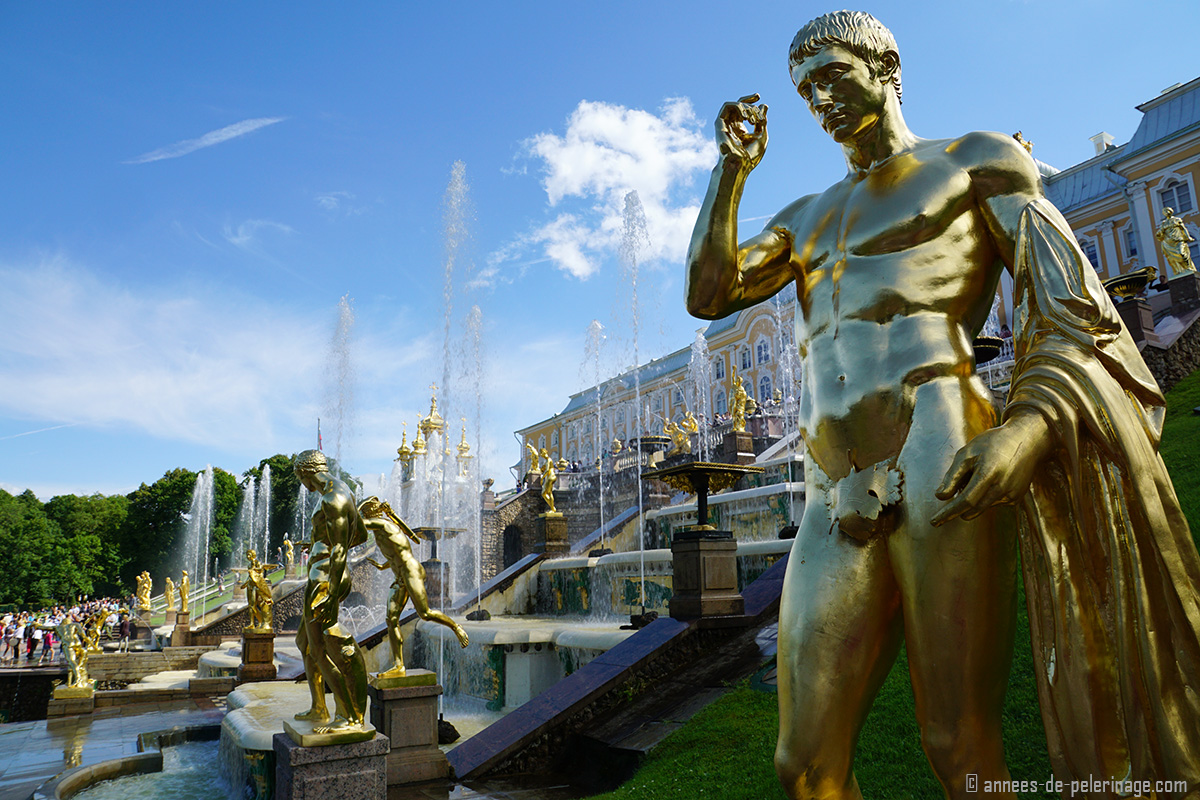
Layout
The dominant natural feature of Peterhof is a 16-m-high bluff lying less than 100 m from the shore. The so-called Lower Gardens (Nizhny Sad), at 1.02 km² comprising the better part of Peterhof’s land area, are confined between this bluff and the shore, stretching east and west for roughly 200 m. The majority of Peterhof’s fountains are contained here, as are several small palaces and outbuildings. East of the Lower Gardens lies the Alexandria Park with 19th-century Gothic Revival structures such as the Kapella.
Atop the bluff, near the middle of the Lower Gardens, stands the Grand Palace (Bolshoi Dvorets). Behind (south) of it are the comparatively small Upper Gardens (Verhnyy Sad). Upon the bluff’s face below the palace is the Grand Cascade (Bolshoi Kaskad). This and the Grand Palace are the centrepiece of the entire complex. At its foot begins the Sea Channel (Morskoi Kanal), one of the most extensive waterworks of the Baroque period, which bisects the Lower Gardens.
佈局
Peterhof的主要自然特徵是距離海岸不到100米的16米高的虛張聲勢。 所謂的下花園(Nizhny Sad),佔地1.02平方公里,包括彼得霍夫陸地區的較大部分,被限制在這個虛張聲勢和海岸之間,向東和向西伸展約200米。 這裡有大多數彼得霍夫的噴泉,以及幾座小宮殿和附屬建築。 位於下花園東側的亞歷山大公園(Alexandria Park)擁有19世紀的哥特復興建築,如卡佩拉(Kapella)。
在下花園中間的懸崖頂上,矗立著大皇宮(Bolshoi Dvorets)。 在它的後面(南部)是相對較小的上花園(Verhnyy Sad)。 在宮殿下面的虛張聲勢是大瀑布(Bolshoi Kaskad)。 這和大皇宮是整個建築群的核心。 在它的腳下開始了海峽航道(Morskoi Kanal),這是巴洛克時期最廣泛的水廠之一,將下花園一分為二。
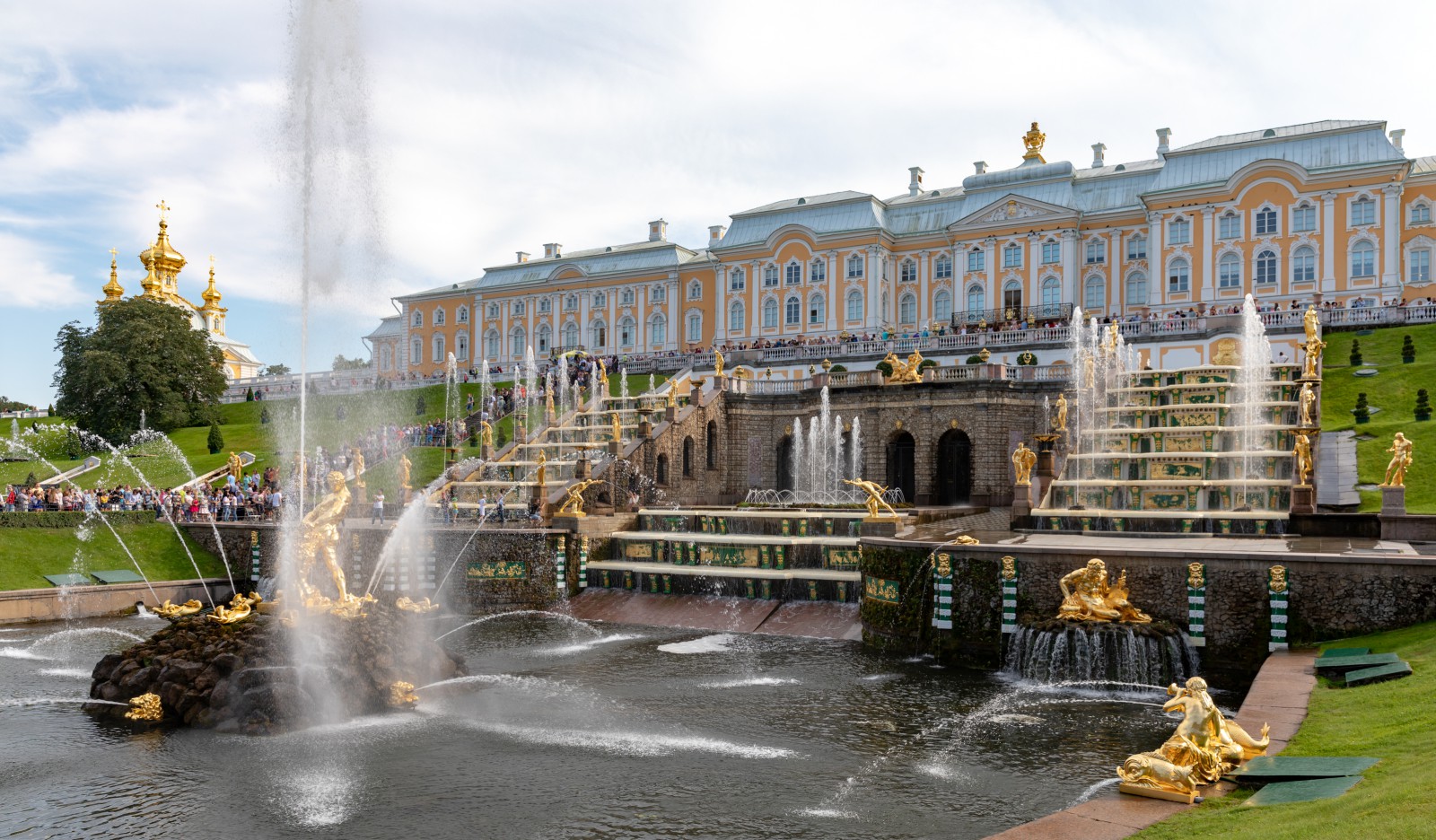
The Grand Cascade and Samson Fountain
The Grand Cascade is modelled on one constructed for Louis XIV at his Château de Marly,which is likewise memorialised in one of the park’s outbuildings.
At the centre of the cascade is an artificial grotto with two stories, faced inside and out with hewn brown stone. It currently contains a modest museum of the fountains’ history. One of the exhibits is a table carrying a bowl of (artificial) fruit, a replica of a similar table built under Peter’s direction. The table is rigged with jets of water that soak visitors when they reach for the fruit, a feature from Mannerist gardens that remained popular in Germany. The grotto is connected to the palace above and behind by a hidden corridor.
The fountains of the Grand Cascade are located below the grotto and on either side of it. There are 64 fountains. Their waters flow into a semicircular pool, the terminus of the fountain-lined Sea Channel. In the 1730s, the large Samson Fountain was placed in this pool. It depicts the moment when Samson tears open the jaws of a lion, representing Russia’s victory over Sweden in the Great Northern War, and is doubly symbolic. The lion is an element of the Swedish coat of arms, and one of the great victories of the war was won on St Sampson’s Day. From the lion’s mouth shoots a 20-metre-high vertical jet of water, the highest in all of Peterhof. This masterpiece by Mikhail Kozlovsky was looted by the invading Germans during the Second World War; see History below. A replica of the statue was installed in 1947.
Perhaps the greatest technological achievement of Peterhof is that all of the fountains operate without the use of pumps. Water is supplied from natural springs and collects in reservoirs in the Upper Gardens. The elevation difference creates the pressure that drives most of the fountains of the Lower Gardens, including the Grand Cascade. The Samson Fountain is supplied by a special aqueduct, over 4 km in length, drawing water and pressure from a high-elevation source.
大瀑布和參孫噴泉
Grand Cascade仿照路易十四在他的ChâteaudeMarly建造的那個,同樣在公園的一個附屬建築中進行紀念。
在瀑布的中心是一個人工石窟,有兩層樓,裡面和外面都是棕色的石頭。它目前包含一個溫泉博物館的歷史博物館。其中一個展品是一張桌子,上面放著一碗(人造)水果,是在彼得方向下建造的類似桌子的複製品。桌子上裝滿了水流,當遊客到達水果時會吸引遊客,這是Mannerist花園的特色,在德國仍然很受歡迎。石窟通過隱藏的走廊連接到宮殿的上方和後方。
大瀑布的噴泉位於石窟下方及其兩側。有64個噴泉。他們的水流入半圓形的水池,是噴泉襯裡的海峽的終點。在1730年代,大型參孫噴泉被放置在這個游泳池中。它描繪了當參孫撕裂獅子的下顎,代表俄羅斯在北方大戰中戰勝瑞典的那一刻,並且具有雙重象徵意義。獅子是瑞典徽章的一部分,在聖桑普森日贏得了戰爭的偉大勝利之一。從獅子的嘴裡射出一個20米高的垂直水射流,是彼得霍夫最高的水射流。米哈伊爾·科茲洛夫斯基的這部傑作在第二次世界大戰期間被入侵的德國人洗劫一空;見下面的歷史。雕像的複製品於1947年安裝。
也許彼得霍夫最大的技術成就是所有噴泉都在不使用泵的情況下運行。水由天然泉水供應,並收集在上花園的水庫中。海拔差異造成了驅動下花園大部分噴泉的壓力,包括大瀑布。 Samson噴泉由一條長4公里的特殊渡槽供水,從高海拔水源吸取水和壓力。
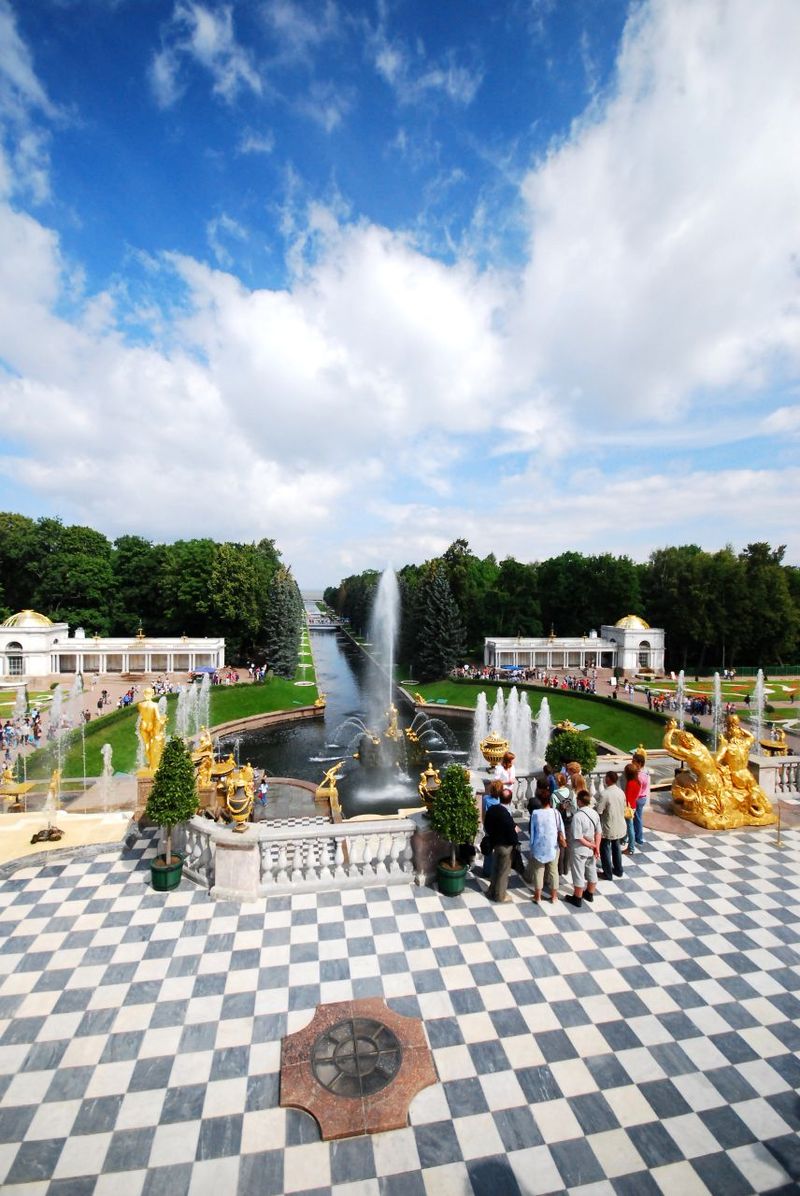
The Lower Gardens
The expanse of the Lower Gardens is designed in the formal style of French formal gardens of the 17th century. Although many trees are overgrown, in the recent years the formal clipping along the many allees has resumed in order to restore the original appearance of the garden. The many fountains located here exhibit an unusual degree of creativity. One of the most notable designs is entitled ‘The Sun’. A disk radiating water jets from its edge creates an image of the sun’s rays, and the whole structure rotates about a vertical axis so that the direction in which the “sun” faces is constantly changing.
The same bluff that provides a setting for the Grand Cascade houses two other, very different cascades. West of the Grand Palace is the Golden Mountain (Золотая Гора), decorated with marble statuary that contrasts with the riotous gilded figures of the Grand Cascade. To the east is the Chess Mountain (Шахматная Гора), a broad chute whose surface is tiled black and white like a chessboard. The most prominently positioned fountains of Peterhof are ‘Adam’ and ‘Eve’. They occupy symmetric positions on either side of the Sea Channel, each at the conjunction of eight paths.
下花園
寬敞的下花園採用17世紀法國正式花園的正式風格設計。雖然許多樹木都長滿了,但近年來,為了恢復花園的原貌,最近幾年已經恢復了正常的剪裁。這裡的許多噴泉都具有不同尋常的創造力。其中一個最著名的設計名為“太陽報”。從其邊緣輻射水射流的圓盤產生太陽光線的圖像,並且整個結構圍繞垂直軸旋轉,使得“太陽”面對的方向不斷變化。
同樣的虛張聲勢為大瀑布提供了另外兩個非常不同的瀑布。大皇宮西側是金山(ЗолотаяГора),裝飾著大理石雕像,與大瀑布的繽紛鍍金人物形成鮮明對比。東邊是像棋山(ШахматнаяГора),這是一個寬闊的滑道,其表面是黑色和白色,像棋盤一樣。彼得霍夫最顯眼的噴泉是“亞當”和“夏娃”。它們佔據海峽兩側的對稱位置,每個位於八條路徑的連接處。
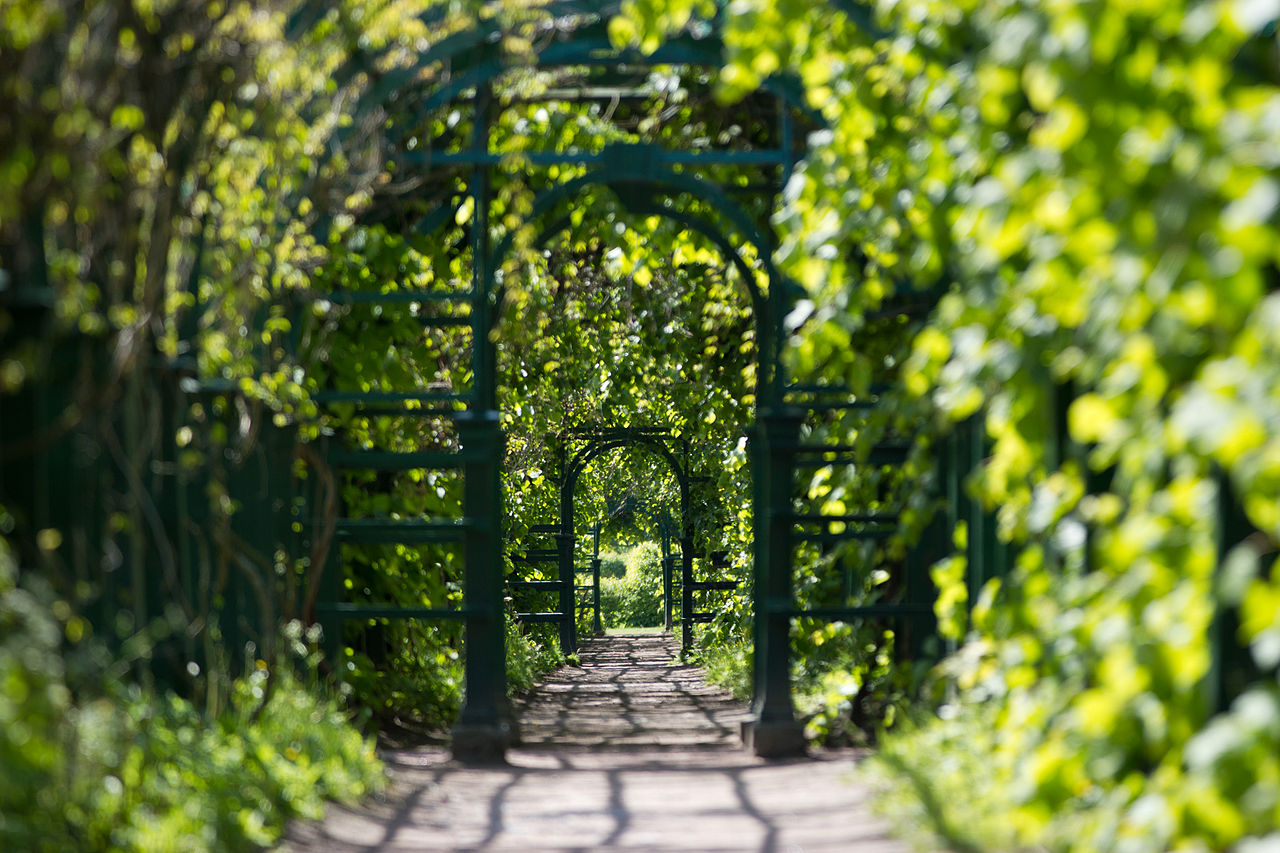
The Grand Palace
The largest of Peterhof’s palaces looks truly imposing when seen from the Lower or Upper Gardens, but in fact it is quite narrow and not overly large. Of its approximately thirty rooms, several deserve mention.
The Chesma Hall is decorated with twelve large paintings of the Battle of Chesma, a stunning naval victory of the Russo-Turkish War, 1768-1774. These were painted between 1771 and 1773 by the German artist Jacob Philipp Hackert. His first renderings of the great battle scenes were criticised by witnesses as not showing realistically the effect of exploding ships — the flying timbers, great flames, smoke, and fireballs. Catherine II assisted the artist by exploding a frigate in the harbour of Livorno, Italy, for the benefit of Hackert, who had never seen a naval battle first-hand. Hackert also did not research the actual positions of the Russian and Turkish forces during the battle, so the scenes depicted are somewhat fanciful, but do effectively convey drama and destruction of naval warfare.
The East and West Chinese Cabinets were decorated between 1766 and 1769 to exhibit objects of decorative art imported from the East. The walls were decorated with imitation Oriental patterns by Russian craftsmen, and hung with Chinese landscape paintings in yellow and black lacquer. Another room, positioned at the centre of the palace, bears the name of the Picture Hall. Its walls are almost entirely covered by a series of 368 paintings, mostly of variously dressed women, differing in appearance and even age, yet most were drawn from a single model. These were purchased in 1764 from the widow of the Italian artist P. Rotari, who died in St. Petersburg.
大皇宮
從下花園或上花園看,彼得霍夫宮殿中最大的宮殿看起來真的很壯觀,但實際上它很窄而且不是太大。在大約三十個房間中,有幾個值得一提。
切斯馬大廳裝飾著十二幅Chesma戰役的大型畫作,這是1768年至1774年俄土戰爭的驚人海軍勝利。這些是1771年至1773年間由德國藝術家Jacob Philipp Hackert繪製的。他對戰斗場面的第一次渲染被證人批評為沒有真實地展示爆炸船隻的效果 – 飛行的木材,巨大的火焰,煙霧和火球。凱瑟琳二世通過在意大利裡窩那海港的一艘護衛艦上爆炸,為哈克特的利益提供了幫助,後者從未見過第一手海戰。哈克特也沒有研究俄羅斯和土耳其軍隊在戰鬥中的實際位置,因此所描繪的場景有些奇特,但確實有效地傳達了海戰的戲劇性和毀滅性。
東方和西方的中國櫥櫃在1766年至1769年之間進行裝飾,以展示從東方進口的裝飾藝術品。牆壁上裝飾著俄羅斯工匠仿製的東方圖案,並掛著黃色和黑色漆器的中國山水畫。另一間客房位於宮殿的中心,擁有圖片廳的名稱。它的牆壁幾乎完全被一系列368幅畫作所覆蓋,其中大部分是穿著不同的女性,外觀和年齡都不同,但大部分是從單一模特中抽出來的。這些是1764年從意大利藝術家P. Rotari的遺囑中購買的,他在聖彼得堡去世。
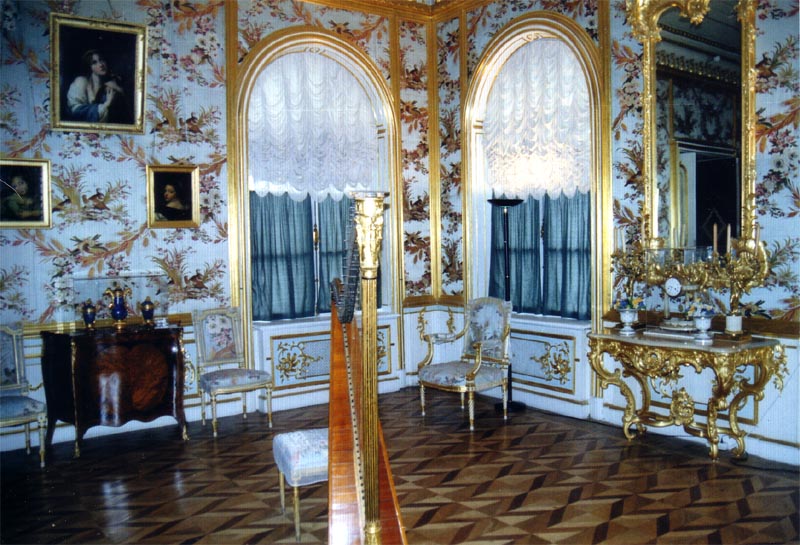
Other features
The Grand Palace is not the only historic royal building in Peterhof. The palaces of Monplaisir and Marli, as well as the pavilion known as the ‘Hermitage’, were all raised during the initial construction of Peterhof during the reign of Peter the Great. The Lower Gardens also contain a large greenhouse, and in the Alexandrine Park stands the palace of Nicholas I.
Like the Lower Gardens, the Upper Gardens contain many fountains, distributed among seven broad pools. The landscaping, though, is entirely different; unlike the Lower Gardens (which are strictly geometric), the Upper Gardens are not. A few of the fountains have curious sculptures.
其他特性
大皇宮不是彼得霍夫唯一的歷史悠久的皇家建築。 Monplaisir和Marli的宮殿,以及被稱為“冬宮”的亭子,都是在彼得大帝統治時期彼得霍夫的最初建造期間長大的。 下花園還有一個大溫室,亞歷山大公園內有尼古拉斯一世的宮殿。
與下花園一樣,上花園包含許多噴泉,分佈在七個寬闊的游泳池中。 然而,景觀美化完全不同; 不像下花園(嚴格幾何),上花園不是。 一些噴泉有好奇的雕塑。
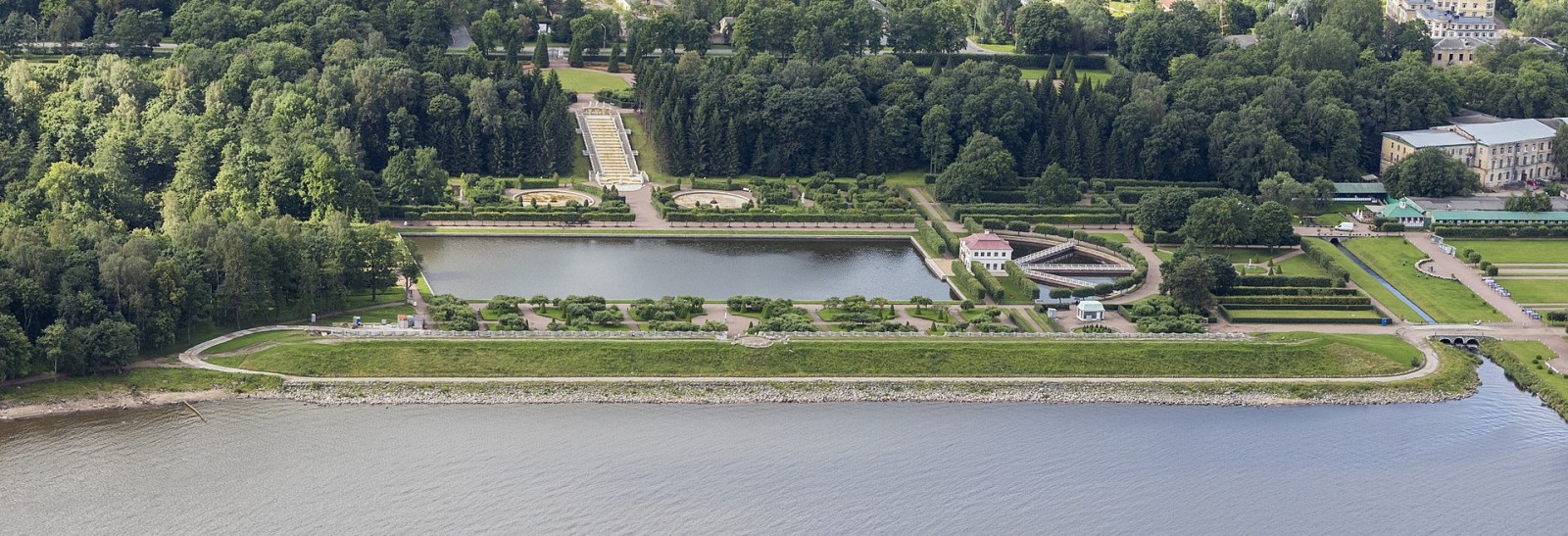
FROM:https://en.wikipedia.org/wiki/Peterhof_Palace
FROM:Sankt Petersburg – Peterhof. 4K Ultra HD
FROM:Peterhof Palace, Drone, Russia
Don’t you think it’s addictive?
Want to know more about the beauty of architecture?
Come and join our members to explore the beauty of architectural design.
覺得看得不過癮嗎?
想要知道更多建築之美嗎?
快來加入我們的會員,一同探索建築設計之美。
The above article is purely for appreciation and sharing purposes, as well as the construction of new technology and the public can be in-depth understanding of the information at the same time there are sources, will be able to query, no use of the document as a commercial transaction, if illegal, please inform the We will immediately remove the site, thank you for cooperation.
以上文章純粹作為欣賞及分享用途,以及將建築新型技術傳遞給與大眾能夠深入了解,同時資料還有來源,將可查詢,絕無使用該文件資料作為商業交易行為,如有違法請務必告知該網站我們將立即處理撤除,謝謝合作。

